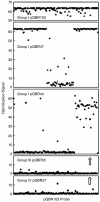Sequence-based analysis of pQBR103; a representative of a unique, transfer-proficient mega plasmid resident in the microbial community of sugar beet
- PMID: 18043644
- PMCID: PMC2656933
- DOI: 10.1038/ismej.2007.47
Sequence-based analysis of pQBR103; a representative of a unique, transfer-proficient mega plasmid resident in the microbial community of sugar beet
Abstract
The plasmid pQBR103 was found within Pseudomonas populations colonizing the leaf and root surfaces of sugar beet plants growing at Wytham, Oxfordshire, UK. At 425 kb it is the largest self-transmissible plasmid yet sequenced from the phytosphere. It is known to enhance the competitive fitness of its host, and parts of the plasmid are known to be actively transcribed in the plant environment. Analysis of the complete sequence of this plasmid predicts a coding sequence (CDS)-rich genome containing 478 CDSs and an exceptional degree of genetic novelty; 80% of predicted coding sequences cannot be ascribed a function and 60% are orphans. Of those to which function could be assigned, 40% bore greatest similarity to sequences from Pseudomonas spp, and the majority of the remainder showed similarity to other gamma-proteobacterial genera and plasmids. pQBR103 has identifiable regions presumed responsible for replication and partitioning, but despite being tra+ lacks the full complement of any previously described conjugal transfer functions. The DNA sequence provided few insights into the functional significance of plant-induced transcriptional regions, but suggests that 14% of CDSs may be expressed (11 CDSs with functional annotation and 54 without), further highlighting the ecological importance of these novel CDSs. Comparative analysis indicates that pQBR103 shares significant regions of sequence with other plasmids isolated from sugar beet plants grown at the same geographic location. These plasmid sequences indicate there is more novelty in the mobile DNA pool accessible to phytosphere pseudomonas than is currently appreciated or understood.
Figures




References
-
- Bailey MJ, Kobayashi N, Lilley AK, Powell BJ, Thompson IP. Potential for gene transfer in the phytosphere: isolation and characterisation of naturally occurring plasmids. In: Bazin MJ, Lynch JM, editors. Environmental Gene Release. Chapman & Hall; London, UK: 1994. pp. 77–98.
-
- Bailey MJ, Lilley AK, Diaper JD. Gene transfer in the phyllosphere. In: Morris CE, Nicot P, Nguyen-the C, editors. Microbiology of Aerial Plant Surfaces. Plenum Publishing; New York, USA: 1996. pp. 103–123.
-
- Bailey MJ, Rainey PB, Zhang X-X, Lilley AK. Population dynamics, gene transfer and gene expression in plasmids, the role of the horizontal gene pool in local adaptation at the plant surface. In: Lindow SE, Hecht-Poinar I, Elliott VJ, editors. Microbiology of Aerial Plant Surfaces. American Phytopath. Soc. Press; St Paul, USA: 2001. pp. 171–189.
-
- Barkay T, Miller SM, Summers AO. Bacterial mercury resistance from atoms to ecosystems. FEMS Microbiol Rev. 2003;27:355–384. - PubMed
Publication types
MeSH terms
Associated data
- Actions
Grants and funding
LinkOut - more resources
Full Text Sources
Miscellaneous

